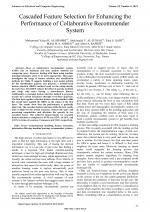| 4/2018 - 3 |
Cascaded Feature Selection for Enhancing the Performance of Collaborative Recommender SystemAL-SHAMRI, M. Y. H. |
| Extra paper information in |
| Click to see author's profile in |
| Download PDF |
Author keywords
computational modeling, feature extraction, information filtering, machine learning, recommender systems
References keywords
systems(18), recommender(16), learning(9), machine(8), data(8), collaborative(7), system(6), selection(6), recommendation(6), filtering(6)
Blue keywords are present in both the references section and the paper title.
About this article
Date of Publication: 2018-11-30
Volume 18, Issue 4, Year 2018, On page(s): 23 - 34
ISSN: 1582-7445, e-ISSN: 1844-7600
Digital Object Identifier: 10.4316/AECE.2018.04003
Web of Science Accession Number: 000451843400003
SCOPUS ID: 85058813839
Abstract
Most of collaborative recommender systems (CRSs) rely on statistical and data analysis methods for comparing users. However, dealing with them using machine learning techniques seems to be more appropriate. This paper investigates the usage of feature selection and classification methods for CRSs. It suggests building a user model suitable for the classification purpose and proposes a density-based feature selection (DBFS) method based on the rating density for each class. The DBFS reduces the effect of sparsity problem and keeps only users having a dense-feature history. Additionally, a cascaded feature selection method is proposed to pick out a subset of features through a two-layer approach. The first layer applies a classical feature selection method while the second layer applied the DBFS on the output of the first layer. The results show that the performance is gradually improved. The cascaded feature selection yields the best results since it improves the system accuracy, reduces the space and processing complexities, and alleviates the sparsity in two cascaded layers. The achieved improvements by cascaded feature selection as compared to SVM are 6.55 percent, 10.14 percent, and 3.92 percent in terms of accuracy, F-measure and MAE, respectively. |
| References | | | Cited By |
Web of Science® Times Cited: 1 [View]
View record in Web of Science® [View]
View Related Records® [View]
Updated 2 weeks, 5 days ago
SCOPUS® Times Cited: 1
View record in SCOPUS® [Free preview]
View citations in SCOPUS® [Free preview]
[1] Practice challenge recommendations in online judge using implicit rating extraction and utility sequence patterns, P Natarajan, Ramesh, S, Kannimuthu, D, Bhanu, Data Technologies and Applications, ISSN 2514-9288, Issue 5, Volume 58, 2024.
Digital Object Identifier: 10.1108/DTA-10-2023-0688 [CrossRef]
Disclaimer: All information displayed above was retrieved by using remote connections to respective databases. For the best user experience, we update all data by using background processes, and use caches in order to reduce the load on the servers we retrieve the information from. As we have no control on the availability of the database servers and sometimes the Internet connectivity may be affected, we do not guarantee the information is correct or complete. For the most accurate data, please always consult the database sites directly. Some external links require authentication or an institutional subscription.
Web of Science® is a registered trademark of Clarivate Analytics, Scopus® is a registered trademark of Elsevier B.V., other product names, company names, brand names, trademarks and logos are the property of their respective owners.
Faculty of Electrical Engineering and Computer Science
Stefan cel Mare University of Suceava, Romania
All rights reserved: Advances in Electrical and Computer Engineering is a registered trademark of the Stefan cel Mare University of Suceava. No part of this publication may be reproduced, stored in a retrieval system, photocopied, recorded or archived, without the written permission from the Editor. When authors submit their papers for publication, they agree that the copyright for their article be transferred to the Faculty of Electrical Engineering and Computer Science, Stefan cel Mare University of Suceava, Romania, if and only if the articles are accepted for publication. The copyright covers the exclusive rights to reproduce and distribute the article, including reprints and translations.
Permission for other use: The copyright owner's consent does not extend to copying for general distribution, for promotion, for creating new works, or for resale. Specific written permission must be obtained from the Editor for such copying. Direct linking to files hosted on this website is strictly prohibited.
Disclaimer: Whilst every effort is made by the publishers and editorial board to see that no inaccurate or misleading data, opinions or statements appear in this journal, they wish to make it clear that all information and opinions formulated in the articles, as well as linguistic accuracy, are the sole responsibility of the author.



